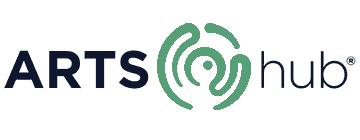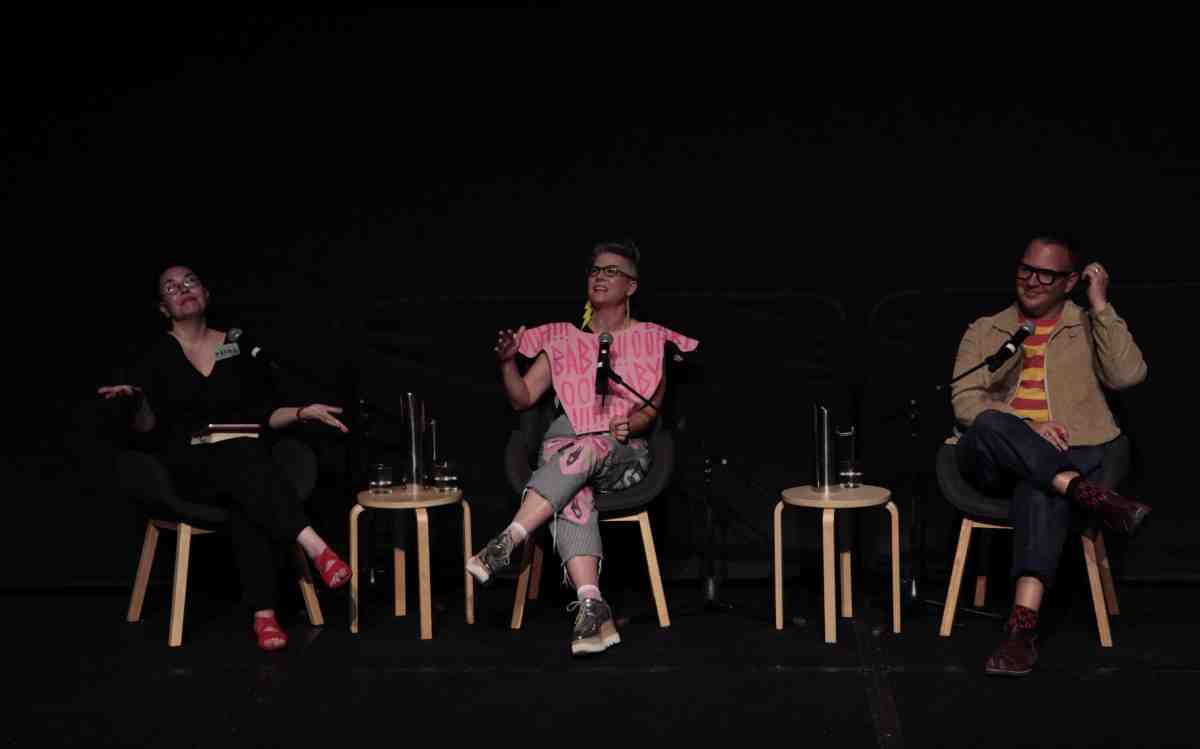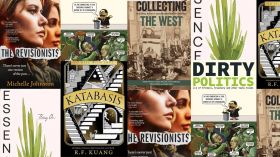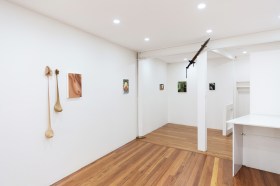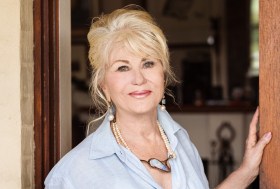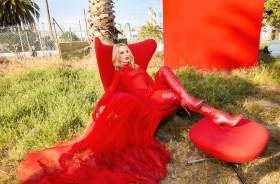We all know by now that capitalism isn’t the perfect model that some envisioned it to be, but to what extent does it impact the value, both socially and economically, of creative labour?
In Chokepoint Capitalism: How Big Tech and Big Content Captured Creative Labour Markets and How We’ll Win Them Back, US activist Cory Doctorow and Melbourne-based scholar Rebecca Giblin rally for action against the power of large corporations that garner more than their fair share from the labour of artists and creators.
Arts leader, advocate, and Editor of Meanjin, Esther Anatolitis sat down with Giblin and Doctorow at ACMI this week (14 February 2023) to discuss their findings, and the insights that could lead to a fairer future.
Giblin said: ‘One of the many big lies is the idea that capitalism is all about competition. But at least for the last 40 years, what we’ve seen is people systematically set out to eliminate that at every possible place.’
She continued that, instead of competing for the demand of a certain product, big corporations like Amazon, Spotify and Audible are taking a different approach. ‘The way people get really rich is they take a market of buyers and sellers, and distort it into an hourglass shape where there are the buyers at one end and the sellers at the other. Squatting predatorily at the neck, they get to mediate access between the two and, by doing that, squeeze out far more than a fair share of value,’ said Giblin.
That’s the definition of a ‘chokepoint’. Further, Doctorow pointed out that distribution is often ignored in the economic equation, which is to say ‘it doesn’t matter who gets the pie as long as the pie is getting bigger’.
Doctorow continued: ‘For the past few decades, you may have noticed that we’ve been expanding copyright; it lasts longer, it covers more kinds of works, statutory and exemplary damages are higher in the US… Indeed if you don’t care about distribution, this looks like a win because the five publishers, four studios, three record labels, two ad tech companies and one company that runs all the ebooks and audiobooks in the world are richer than they have ever been.
‘But in real terms, the incomes of artists have fallen – artists are poorer, their works are making more money. This is what you get when you say it doesn’t matter who gets which slice of the pie, all that matters is the pie gets bigger,’ said Doctorow.
The scary thing is that this is often hidden away from consumers, many of whom are unknowingly giving their money to big shareholders rather than to the creators of the content they love.
Distribution and allocation will be another key indicator as the National Cultural Policy comes into effect, added Giblin. ‘[The culture industries] need money, but the next thing we need is to make sure that money reaches the right pockets. It’s the allocation of money that’s the issue.’
A promising sign is the extension of Public Lending Rights to ebooks and audiobooks for the first time, which means that Australian authors will be paid royalties for library borrowings of physical books, as well as digital editions. ‘That’s the kind of intervention we need, and we need to be thinking about how we do that in other areas,’ said Giblin.
What is ‘monopsony’ and how does it affect creatives
Monopoly is – apart from being a popular board game – where a seller has market power. It’s when sellers can set prices because buyers don’t have the power to negotiate.
A monopsony, on the other hand, is when that power is with a buyer, typically seen in the labour markets. But as Chokepoint Capitalism notes, ‘One important and under-recognised characteristic of monopsony power is that it can arise at much lower concentrations than monopoly does: a buyer responsible for just 10 or 20 percent of a producer’s sales can have substantial power.’
This has been exemplified in the way Amazon has power over publishers. Because of this control, which for some small publishers can account for more than 80% of sales, Amazon is able to squeeze the publishers’ margins and, in effect, further decrease the trickle-down earnings of writers, independent booksellers and associated employees such as editors.
It’s this dominant power that ensures the likes of Amazon, Spotify and Apple get to set the rules, to the detriment of those who are actually creating the works.
So what should we do? Giblin said that guilt is not the answer. ‘Guilt and shame are paralysing; we don’t need to waste our time on that. We need to accept the reason we use these services is because very smart people have invested billions of dollars in making sure that there is nowhere else for you to go.
‘What we have to do with that energy instead is mobilise and understand that we’re part of the same fight. It’s not just artists’ rights that are at issue here or whether artists are getting paid. We are all increasingly struggling under these economic conditions, as a growing concentration of wealth means that there is less and less for the rest of us,’ says Giblin.
Read: Making an arts advocacy plan
Creatives need stay accountable for the value of their work
Another issue that Anatolitis raised, which specifically relates to the culture sector, is the oversupply of creative labour, where many people are willing to work for less or even work free of charge because they think they are doing what they love.
Giblin said this is the exact attitude that needs to change, and everyone needs to be kept accountable. ‘I work very closely with artists and they keep telling me, “But of course, I would do it for free.” Stop saying that!’ she said.
‘There’s been extensive literature in the field of cultural economics, looking at the material conditions around creative labour. We know that creative workers will do that work for less than [they would for] other forms of labour… In many cases it’s a job that allows you some kind of intrinsic satisfaction, so under the system that we inhabit right now, the understanding is that we shouldn’t get paid for that [satisfaction]. We should get paid to fill a hollow emptiness inside of us [created by the work] and the more emptiness you feel, the higher your salaries.’
Unions and guilds are one way that creators can keep each other accountable, where ‘everybody has to commit to a collective pledge to not work below the union minimum,’ said Giblin.
This collective action, which has more bargaining power than an individual one, could be used to stand against corporate exploitation. In the book Chokepoint Capitalism, Giblin and Doctorow further point out that creatives such as authors, singers and artists are highly visible. They suggest that if 50 of the bestselling authors refused to let Audible host their audiobooks unless it removed DRM (digital rights management) protection (which locks users into the software and device of the platform from which the audiobooks were purchased), it would be gone in a month. Or if hundreds of leading recording artists and their fans boycotted platforms that didn’t meet minimum ethical standards, a new fair trade-style certificate would become the norm.
Read: Recognise Artists as Workers petition gains over 5800 signatures
At ACMI Doctorow explained how this idea of the collective seems to run in the arts, but it doesn’t go far enough to empower creatives and buy them more bargaining power. ‘We have been told that artists are supposed to be individual creators but, in the last decade or two, there’s been a movement to take back the idea that art is a collective endeavour, but only in the creation and not in the economics.
‘What we’ve seen is that artists as individual bargainers are grossly outmatched, and the default response to whenever this goes wrong (which it does all the time) is to increase the copyrights with which artists have to bargain. It’s like giving a bullied kid extra lunch money – there’s no amount of lunch money that’s going to get your kid fed [if you don’t take care of the bullies].
‘What it may do is make the bullies rich and they run a national ad campaign saying “Think of Australia’s hungry schoolchildren and give them even more lunch money”.’
And, again, the solution comes back to building a community, a network, and taking collective action. Case examples in Chokepoint Capitalism, such as strikes organised by the Writers Guild of America (WGA) for Hollywood writers and Taylor Swift’s UMG deal in 2018 – which ensured all of the label’s artists now receive a slice of Spotify shares – show that change is possible.
The final chapter of Chokepoint Capitalism is a call to unite, and it also highlights other key actions that need to take place to build a future where creative workers get a fair share of the wealth generated by their work.
These include advocating for the transparency of information, such as around how royalty payments are calculated, simplifying licensing, moving towards cooperative ownership, putting time limits on copyright contracts and mandating a minimum wage for creative work.
As the authors point out, ‘We need to recognise that the strip-mining of creative workers is part of a broader project in service of an oligarchy.’
Chokepoint Capitalism: Rebecca Giblin and Cory Doctorow in conversation with Esther Anatolitis was presented at ACMI, Melbourne on Tuesday 14 February. ArtsHub attended as a guest of ACMI.
